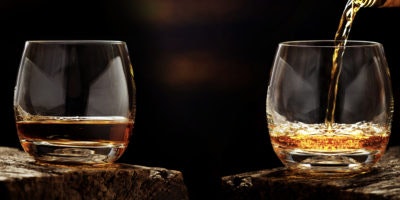Moonshine’s reputation is most commonly its connotation – awful tasting, illegally made booze from some guy’s bathtub that’ll blind you if you can even keep it down. Thankfully though, today there’s a growing number of moonshine producers who are churning out some quite good shine.
Does moonshine have a definition?
We need to clear up the confusion over the actual definition of moonshine though. Can moonshine even be made legally, or does moonshine, by definition, inherently equate to something illegally made?
“There are still some that hold firm to the conviction that ‘moonshine’ can only being designated as spirits made illicitly,” says Tara Price of Black Draft Distillery, producers of First Harvest Moonshine. “We choose to identify with moonshine more in fashion with our cultural heritage and a product that is handcrafted in our traditions of West Virginia.”
So, can it be “moonshine” if it’s legal? “I don’t think so,” says Price. Yet, they of course are selling product made legally which is marketed as moonshine.
“Since when have technicalities governed what people call their whiskey,” asks Phil Brandon of Rock Town Distillery, producers of Arkansas Lightning. Good point. He defines moonshine as “any illegally produced untaxed beverage alcohol.” Yet, with no TTB classification – and why would the TTB classify something which is illegally produced? – “you could call anything you want moonshine on the label,” says Brandon. “Moonshine has and can be made from anything.”
Is true moonshine illegal?
So we’ve determined that moonshine has to be illegal. Yet, legal producers are calling their wares moonshine anyway, because they can, and because it harkens back to a tradition and certain style.
“We kind of go with what the old timers did,” says Chuck Miller of Belmont Farm Distillery, producers of Virginia Lightning, as well as Climax Moonshine, made legally for former illegal shiner Tim Smith from the Discovery Channel Moonshiners program.
The moonshine produced by all three aforementioned distilleries is essentially an un-aged corn whiskey. They have a mash bill of at least 80% corn, as is the majority of what is being sold as moonshine today.
“We’re just doing old time recipes, using old time ways, like they’ve been doing in Virginia for 400 years,” says Miller. “It was by the light of the moon. Corn was abundant, corn was cheap. So they made it out of corn. The sugar got added later.”
How is moonshine made?
Rye, barley, wheat and other grains can also be used, sugar was traditionally added for both flavor as well as to stretch the proofing and volume, and moonshine can even be made from all sugar recipes, although then it’s clearly not whiskey, and that reopens the debate of what moonshine is or isn’t.
Miller is also a stickler for another point. “Moonshine is a whiskey made in a copper pot still. To me, if it’s not made in a pot still, how could it be moonshine?” While insisting upon a pot still production process, Miller addresses the previous issue as well, as he doesn’t even believe that all-sugar moonshine is indeed moonshine.
So what have we learned? Moonshine = illegal. But that doesn’t really matter, as long as it throws back to tradition and is made in a pot still, that the moonshine you’re buying at the store is most likely, but not always, unaged corn whiskey.
If you’ve taken a shine to ‘shine, we can help point you to the right stuff.
With Distiller, you’ll always know what’s in the bottle before you spend a cent. Rate, Review, and Discover spirits! Head on over to Distiller, or download the app for iOS and Android today!



